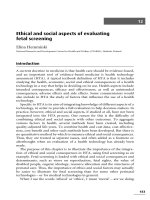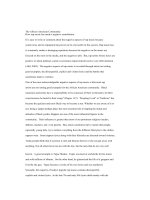Presentations SOCIOLINGUISTICS ASPECTS
Bạn đang xem bản rút gọn của tài liệu. Xem và tải ngay bản đầy đủ của tài liệu tại đây (1.78 MB, 107 trang )
SOCIOLINGUISTICS ASPECTS
Group 2 – K18:
Nguyen Thi Nhu Quynh
Nguyen Thi Phuong
Duong Thi Nhan
Do Thi Phuong Thuy
Tran Thi Oanh
Dinh Thi Thu Thuy
Mai Tuyet Nhung
Hoang Thi Huyen
Pham Thi Tuyet Mai (K17C)
I. INTRODUCTION
II. DEVELOPMENT
Definitions of sociolinguistics
The constitution of the discipline
of sociolinguistics
III. CONCLUSION
DEFINITION
Sociolinguistics is the study of the effect of any and all aspects of
society, including cultural norms, expectations, and context, on the way
language is used.
Difference
Sociolinguistics
The effect of the society
on the language
Sociology of language
The language’s effect
on the society
It also studies how language varieties differ between groups separated
by certain social variables, e.g., ethnicity, religion, status, gender, level
of education, age, etc., and how creation and adherence to these rules
is used to categorize individuals in social or socioeconomic classes.
THE CONSTITUTION OF THE
DISCIPLINE OF SOCIOLINGUISTICS
1. Definitions of language
2. Pidgins
3. Creole
4. Style
5. Bilingualism
6. Diglossia
7. Standard dialects
8. Register
9. Language planning and policy
Introduction to
Language
What is language?
Two ways of definitions:
Language is the method of human communication, either spoken or
written, consisting of the use of words in a structured and conventional
way
According to Shan Wareing, there are several different ways of thinking
about language, which way you think about it depends on which aspect
of language you are interested in.
Aspects of language
Aspects
of Language
A system
The potential
to create
a new meaning
Multiple
functions
Language
diversity
Language: a system
A systematic way of combining smaller units into larger units for the
purpose of communication.
Example: We combine the sounds of our language (phonemes) to form words
(lexical items) according to the rules of language. The lexical items can be
combined to make grammatical structures according to the syntactic rules of our
language.
Every group of sounds or letters which make up a word has a one-toone relationship with a meaning; and every meaning you can think of,
there is a corresponding group of sounds (a spoken word) and letters
(a written word).
Example: The meaning “stop”, we have a red traffic light; and for the meaning “go”,
we use a green traffic light
Language: The potential
to create new meanings
What you can see is that words can be used in new
ways to mean new things, and can be understood by
people who hear and see for the first time.
Some expressions which illustrate language being used
creatively to express new meanings:
Unleaving
McDonaldisation
Being perved at
Sweatshirting
Language: multiple
functions
The affective function of language: is concerned
with who is “allowed” to say what to whom, which is
deeply tied up with power and social status.
Example: You can use any of four utterances below and convey the same
factual information:
Put the newspapers on the table.
Can you put the newspapers on the table.
I wonder if you’d mind putting the newspapers on the table, please.
Language diversity
Language boundaries and national boundaries frequently
coincide but in fact the picture is more complicated than that.
In many places which are not England or France, English or French is
spoken (such as India, Canada and many African countries).
In different countries, different versions of English or French are
spoken. Indian English is different in some of its grammatical structures
from British English, as well as in its pronunciation.
Language does not vary only between countries; they also vary within
countries.
Some suggestions for
language teaching
When teaching language, the teachers need focus on all aspects
of language so that students can acquire:
Linguistic knowledge:
Knowledge of the sound system: Knowing what sounds are in that
language and what sounds are not.
Knowledge of words: Knowing the sound units that are related to specific
meanings.
Knowledge of sentences: Knowing how to form sentences.
Linguistic competence: What students know about language.
Linguistic performance: How students use this knowledge in actual
speech production and comprehension.
Pidgins
1.
2.
3.
4.
5.
Definition of Pidgins
The origin of Pidgins
Types of Pidgins
Features of Pidgins
The implications of Pidgins to the language
teaching
1. Definition of pidgins
Pidgin is a new language which develops in situations
where the speakers of different languages need to
communicate but don’t share a common language.
its initial, highly restricted, purpose :
trade
other matters relevant for survival and co-existence
Look at the examples
Pilau
Baboox
Choke
I wen fix da car
You not da boss
Joe no can play
dirty
idiot
a lot of
I fixed the car
You aren’t the boss
You can’t play
2. The origin of Pidgins
Happened on plantations where people of several
different language groups had to live and work together.
A particular language was used to run the plantations, that
is, the plantation language.
When laborers used these words, they changed the
pronunciations, the meanings, and the ways the words
were combined.
Overtime, people got used to using these words in certain
ways and the structures of a new language gradually
formed.
3. Types of Pidgins
3.1. Maritime or Nautical Pidgins:
Used by sailors communicating with people from other nations.
Examples;
Romance based pidgin used all over Mediterranean.
The Basque- Lexifier pidgin of Iceland.
3.2. Trade Pidgins:
Used for trade.
Maritime and trade pidgins are similar.
An example Pidgin Eskimo of Arctic Ocean
Used mainly in and around American ships ( in 19th and 20th century)
3.3. Interethnic Contact Languages:
Used for spread of religion, political negotiations or ceremonies.
Used by people with no common language.
Examples;
Amerindian- Lexifier pidgins:
a) Chinook Jargon of American Northwest( 19th and 20th century)
b) Delaware Jargon ( 17th century)
3.4. Work Force Pidgins:
Formed by contacts between colonial people and local workers.
Butler English and Bamboo English in India.
4. Features of Pidgins
Simplified Morphology.
Reduced inflectional and derivational morphemes (as in
Creoles.)
Variational word order.
Examples:
Subject Verb Object (SVO):
Fanagalo, Zulu- lexifier pidgin spoken in Southern Africa
Mina chena ena first, mina ai az khuluma gagle lo English.
I
tell them first I not can speak well the English.
Object Subject Verb (OSV):
Mobilian Jargon
Tamaha olcifo inu hakkalo banna.
Town
name I hear want.
Phonological system of pidgins is simplified.
For example;
fricatives and /ð/ become stops /b/ and /d/ in Pidgin.
Tones are usually not present in Pidgins.
For Example;
Vietnamese and Chinese are tone languages.
Vietnamese Pidgin French, Chinese Pidgin Russian or Chinese Pidgin
English have no tones.
Pidgins have generally a basic lexical source ( mixture of
different languages.)
Only very few Pidgins show abnormal mixture of
vocabulary.
One Pidgin word may have various meanings.
For Example;
In Chinook Jargon, muckamuck means = Eat, drink, bite and more.
Fewer words are used, many function words are omitted.
Pidgin Hawaiian
Japana, makana dala oe hiamoe ma keia hale wau
Japan, gift dollar me sleep at this house you
5. The implications of Pidgins
to the language teaching
Some Features of Pidgins:
phonology: cluster reduction is common, resulting in a favoring
of CV syllables. Example: dust becomes dus.
morphology: pidgins often have absence of affixal marking
(drop the s-agreement from verbs, for example)
syntax: word order tends to be SVO, prepositions used, articles
not generally used, aspectual distinctions often marked by
auxiliaries
semantics: pidgins usually have small vocabularies with words
with extended meanings. [wikup] means wake up and also 'get
up' (Cameroonian). More compounds employed: dog baby for
puppy.
CREOLES
1
Definitions
2
Reasons for the development
3
Characteristics
DEFINITIONS OF CREOLES
1
2
A Creole is a stable
language that originates
seemingly as a nativized
pidgin.
A Creole is a contact
language that arose
naturally. It does have
native speakers. It has
developed, through
expansion in linguistic
form and grammar, and
extension in use









